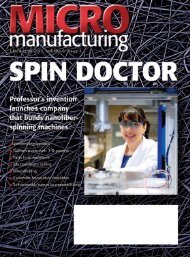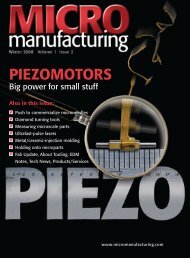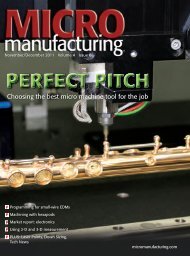to view as PDF - MICROmanufacturing
to view as PDF - MICROmanufacturing
to view as PDF - MICROmanufacturing
You also want an ePaper? Increase the reach of your titles
YUMPU automatically turns print PDFs into web optimized ePapers that Google loves.
No M<strong>as</strong>s Appeal—Yet<br />
Additive manufacturing slowly gains acceptance <strong>as</strong> m<strong>as</strong>s-production option<br />
30 | MAY/JUNE 2012 | <strong>MICROmanufacturing</strong><br />
Things look good for additive manufacturing.<br />
AM technologies have never offered better<br />
performance, and demand for them h<strong>as</strong> never<br />
been greater. Large companies and the U.S.<br />
government are interested.<br />
So is the mainstream media, which h<strong>as</strong> been<br />
covering AM a lot lately. One notable example<br />
is the inclusion of AM in a special report in<br />
The Economist entitled “The third industrial<br />
revolution.”<br />
Unlike subtractive techniques, which<br />
remove material from a workpiece, additivemanufacturing<br />
processes join materials <strong>to</strong><br />
make objects. Guided by 3-D CAD data, AM<br />
systems usually stack thin layers of pl<strong>as</strong>tic, metal<br />
or composites, making the processes suitable<br />
for producing almost any shape or feature,<br />
including those difficult, or impossible, <strong>to</strong> make<br />
via conventional manufacturing processes.<br />
In many c<strong>as</strong>es, AM can fabricate complex and<br />
precise features without secondary operations,<br />
which saves time and money, noted Bill Booth,<br />
vice president of market development for<br />
Microfabrica Inc., an AM firm in Van Nuys,<br />
Calif.<br />
By William Leven<strong>to</strong>n, Contributing Edi<strong>to</strong>r<br />
FineLine Pro<strong>to</strong>typing made these 316L stainless steel jaws via selective l<strong>as</strong>er melting.<br />
FineLine Pro<strong>to</strong>typing<br />
AM processing also consumes less material<br />
than subtractive methods, which proves<br />
especially advantageous when producing parts<br />
from high-cost materials. And, AM can fabricate<br />
monolithic parts that incorporate moving<br />
components.<br />
In 2011, the compound annual growth<br />
rate for additive manufacturing w<strong>as</strong> nearly 30<br />
percent, according <strong>to</strong> a recent report by Wohlers<br />
Associates, a Fort Collins, Colo., consulting<br />
firm that follows AM trends. The firm sees the<br />
industry’s strong growth continuing during<br />
the next several years, with global sales of AM<br />
products and services surp<strong>as</strong>sing $6.5 billion<br />
by 2019.<br />
Despite the rosy picture, a longstanding<br />
question remains: Is AM ready <strong>to</strong> move beyond<br />
its rapid-pro<strong>to</strong>typing (RP) roots and take a<br />
place beside traditional m<strong>as</strong>s-production<br />
technologies?<br />
Holding AM back<br />
At present, AM is still widely considered <strong>to</strong><br />
be more of a one-off, rapid-pro<strong>to</strong>typing process<br />
than a m<strong>as</strong>s-manufacturing option. One re<strong>as</strong>on















